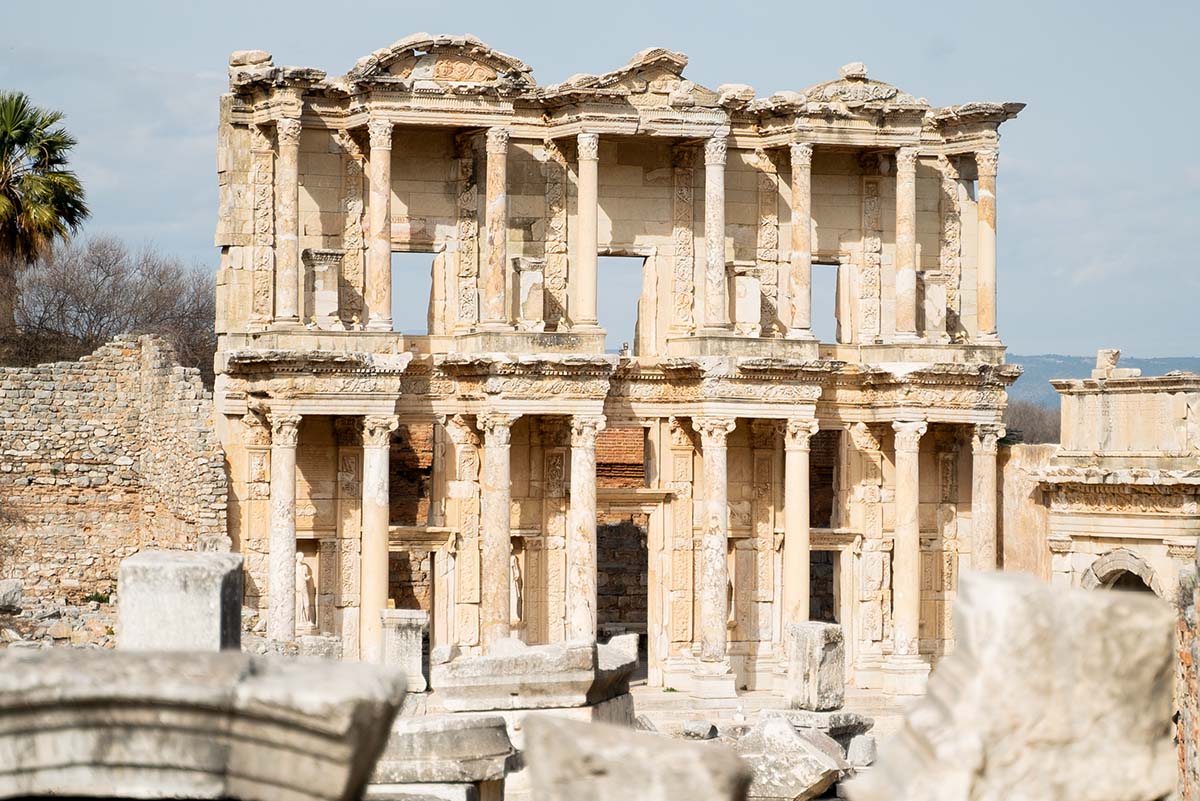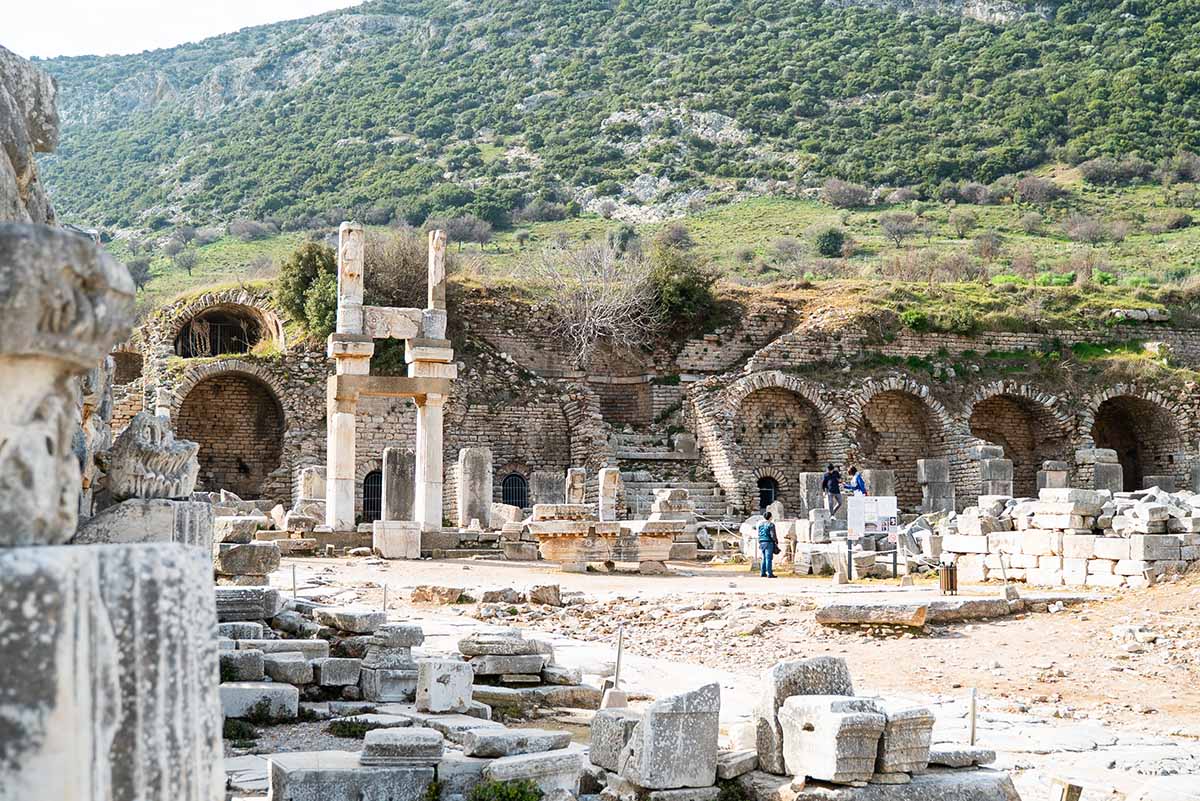Ephesus is one of the most well-known archaeological sites in Turkey, with over 2 million people visiting each year. In Greek and Roman times, it was the commercial centre of the Mediterranean and home to over 250,000 people.
This ancient city lies in the town of Selcuk, an hour’s drive south from the city centre of Izmir. Today, it is known by locals as ‘Efes’ (yes, that is where the popular Turkish beer, Efes, gets its name).
Ephesus is one of the most complete ancient cities in Europe, even though there is still lots of excavation to be done. It is a popular pilgrimage site for Christians and also the home of the Temple of Artemis, one of the seven wonders of the ancient world.
Getting to Ephesus from Izmir
The fastest way to get to Ephesus from Izmir is by car, and it takes roughly an hour to make the 85-kilometre trip.
However, if you don’t have a car, then you may want to consider taking the train. The train ride is lovely and scenic and costs significantly less than hiring a taxi.
We recommend going to Basmane Gari (station) as it is in the heart of Izmir. From there you can take the Basmane-Denizli train to the town of Selcuk where Ephesus is.
Once you get to Selcuk Train Station, you can take a taxi to the ancient city. Or you can walk to Selcuk Bus Station and take one of the minibuses which depart regularly for Efes. The whole trip takes just over 90 minutes, including the one-hour train ride to Selcuk and the minibus to the ruins.
What to see at Ephesus: Top things to see
Ephesus can get crowded in the summer season, so it’s a good idea to arrive early before other tourists arrive. It opens from 8am till 6:30pm in summer and 8:30-5:30pm in winter.
When you arrive, you will be given a map of the city.
While there are dozens of key sites to look out for, here are our top picks.
Celsus Library

One of the most impressive structures at the ruins is this library which was built in the 2nd century AD and was named after the Roman consul, Celsus.
The library was designed to hold 12,000 scrolls and was one of the largest libraries of the ancient world. The facade of the library is adorned with statues of the four virtues: wisdom, knowledge, intelligence, and valor.
The interior of the library is equally impressive, with beautiful frescoes and mosaics.
The Temple of Artemis
The Temple of Artemis, also known as the Temple of Diana, was one of the Seven Wonders of the Ancient World. Unfortunately, only a few columns and fragments of the foundations remain today.
Great Theatre
Along with the Celsus Library, the Great Theatre is also one of the impressive structures in Ephesus. It was built in the 3rd century BC and was used for plays, concerts, and gladiatorial games. The theatre could seat up to 25,000 people and was one of the largest in the ancient world.
Temple of Hadrian
This is of the best structures on Curetes Street at Ephesus. It was dedicated to Emperor Hadrian visiting from Athens in the 2nd century A.D.
Curetes Street

Curetes Street is one of the three main street in Ephesus. It was an important sacred street that led to the Temple of Artemis.
It’s worth checking out the ancient toilets which are quite interesting, given the incredible plumbing and engineering that existed in Greek and Roman times.
Terrace Houses
The Terrace Houses are a series of interconnected houses that were built in the 1st century AD. These houses were the homes of the middle class and wealthy and were adorned with beautiful frescoes, mosaics, and marble floors. They give insight into the daily life of wealthy and middle-class citizens of Ephesus.
House of the Virgin Mary
It is said this small stone house was where the Virgin Mary lived until she died at 101 years old.
Basilica of St John
The Basilica of St. John is a stunning church that was built in the 6th century AD. It was constructed on the site where the apostle John is believed to have been buried. It’s a beautiful example of Byzantine architecture.
Ephesus Museum
This museum displays archaeological artifacts that were found at the Ephesus ruins, including some from the Temple of Artemis and others discovered in surrounding ruins.
History of Ephesus

Visiting Ephesus is like stepping back in time to the ancient world.
It was founded as a colony in the 10th century BC, and it became one of the most important cities in the ancient world. The city was located on the coast of the Aegean Sea, and it was an important port for trade and commerce (today it is located farther back from the sea as the landscape has slowly changed).
Ephesus was ruled by a succession of empires and civilisations, including the Greeks, Persians, Romans, and Byzantines. The city was conquered by Alexander the Great in 334 BC, and it became part of the Roman Empire in 129 BC. Under Roman rule, Ephesus became a major cultural and economic center.
During the early Christian period, Ephesus became an important center of Christianity. The apostle Paul visited the city and established a Christian community there. The Gospel of John was also written in Ephesus. The city was home to several important early Christian figures, including the apostle John and Jesus’s mother, Mary.
Ephesus declined in importance after the 7th century AD, and it was abandoned in the 15th century. Surprisingly, the city was only rediscovered in the 19th century.
Admission fee
As of 2023, the entrance fee to the Ephesus ruins cost 700 TL ($25.46 USD) for tourists. However, it is significantly cheaper for Turkish residents, so be sure to show your ID card if you are a resident to get the cheaper price.
You can either explore the Ephesus ruins on your own or pay one of the guides at the entrance to give you a tour.
As a side note, it’s worth purchasing a Museum Card (Müze Kart) if you plan to visit multiple historical sites, as it gives access to Ephesus in addition to over 300 other historical sites across Turkey. In 2023, the Museum Card cost 60 TL ($2.20 USD) for Turkish residents and 3500 TL ($130 USD) for tourists.
Costs for visiting Ephesus Ancient City in 2023
Ephesus Ancient Ruins – $25.46 USD (700 TL)
House of Mary – $9.01 USD (250 TL)
St John’s Basilica – $4.69 USD (130 TL)
Terrace Houses – $11.54 USD (320 TL)
Ephesus Museum – $7.93 USD (220 TL)
Children under 8 years old are free of charge.
How long should you spend at Ephesus?
Most tourists spend 2-3 hours exploring the ruins of Ephesus. You’ll need longer if you visit surrounding landmarks, such as House of the Virgin Mary and the Museum.
Helpful tip
We spent roughly 2 hours walking through the Ephesus ruins. By then our toddler was exhausted, so we had to leave but thankfully we had taken photos of all the inscriptions to read on the train ride back to our hotel.
If you come kid-free however, you may want more time to read the inscriptions and signs and to take photos, as well as to explore some surrounding sites like the House of Mary, the Terrace Houses, and also visit the Basilica of St John and the Ephesus Museum in the nearby town of Selcuk.
Best time to visit Ephesus
The weather in Ephesus can be quite hot and dry during the summer months, with temperatures reaching as hot as 101.5 F (38.5 Celsius) in summer. The winter months can be cold, with temperatures getting as low as 38.9 F (-3.8 degrees Celsius). The spring and fall months offer more moderate temperatures, with highs in the 70’s F (20’s C) and lows in the 50’s F (10’s C).
Ephesus can get very crowded. The busiest months are June through August, when many tourists flock to the area. If you prefer to avoid crowds, it may be best to visit just before or after summer, the seasons of April-May or September-October. During these months, the weather is still pleasant, but the crowds are smaller.
Where to eat before/after visiting Ephesus
There aren’t many places to eat near the ruins at Ephesus. It’s best to eat at the nearby town of Selcuk where there are restaurants and cafes just a short walk from the train station.
Helpful tip
We arrived at the ruins hungry and ready for breakfast and were disappointed with the overpriced cafes adjoining the ruins. We paid close to $15 USD for a packet of chips and a drink that we shared between us.
Toilet facilities
There are toilets near the entrance of the ruins, and it’s a good idea to use them before you enter the ruins, as it is a long walk from one end to another, especially if you have children. There is a small fee to pay to use the toilets.
What to bring
The streets of Ephesus are paved with worn stones, which can be slippery, so we recommend wearing comfortable shoes with grip. All the white stone can be blinding in summer, so you may want to bring sunglasses and a hat. If we visited again, we’d bring snacks and water as well.
As you visit the ruins of the ancient city of Ephesus, we hope you enjoy being transported back in time to when the city was at the height of its glory. If you’re someone who is interested in history, then be sure to put this this remarkably preserved site on your list of places to visit in Turkey.

I’m a teacher and writer living abroad. I love languages, drinking lots of çay (tea) with friends, experiencing different cultures and going on adventures with my family.




